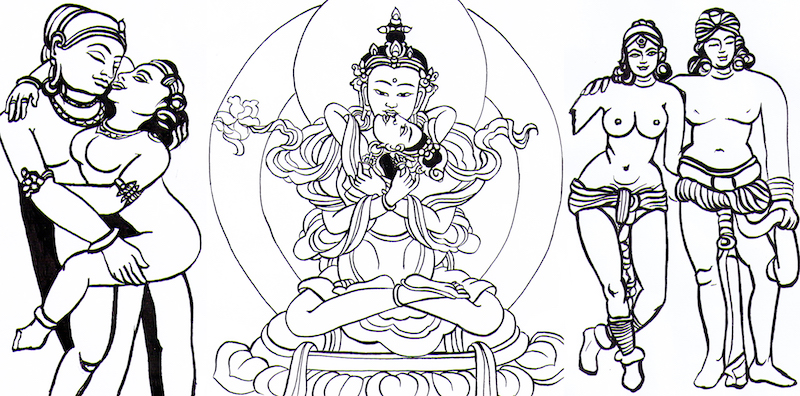Maithuna figures and Tantric deities in union. Drawing by the author
In Vajrayana Buddhism, the male equivalent of a dakini, a female emanation of wisdom (Tib. khandroma), is known as daka in Sanskrit and pawo in Tibetan. Pawo literally means “hero” and it is accepted as the tantric equivalent of a bodhisattva. In tantric practice, daka embodies the process of internal integration of the male principle, its awakening and elevating to a higher level of consciousness. Both daka and dakini have multifaceted nature and play important role in Tantric Buddhism.
In the Western science, the dakini is related to the archetype of the female anima, popularized by the psychology of Carl Gustav Jung (1875-1961). Anima is associated with the female aspect of the psyche of a man, which affects his unconscious behavior.
The awakening of male spiritual potential is only one part of the role of dakini. The other part is connected with the awakening of the potential of the woman that in Jung’s psychology refers to animus or the male principle in female psyche. In this regard, dakini combines both principles of anima and animus and even transcends them, as her enlightened nature is beyond the distinction of gender. The nature of animus can be compare also with the characteristic of daka.
Rob Preece explains the union of daka and dakini from the perspective of Western psychology, using the same model of anima and animus. According to him, “The most dramatic encounter with the archetypal force of these polarities for many people is when they fall in love.” (Preece 1996: 196). One feels complete only when he or she is in intimate union, having overcome his projections that are derived from the power of archetypes. In intimate relationships, both archetypes appear as an idealized image that usually is projected onto an external object. This makes it difficult for one to see the true individuality of the other person, and furthermore, it causes one to cling to the illusory object and long for its particular manifestation in the outer world.
This clinging, according to the Buddhist philosophy and contemporary psychology, is the reason for the fears, hopes, joys and pains that accompany such relationships between people. When the projection does not reflect reality, which gradually is revealed, this creates a conflict with the ideal and ultimately, disappointment and suffering.
The Buddhist concepts of femininity can be applied in terms of universal human relationships that are beyond a certain historical time, geographical area or religious beliefs. The figure of dakini has timeless role as one of the archetypes of human culture. She embodies the feminine principle that should be cultivated towards the ultimate spiritual realization. As an image that appears together with a daka, she symbolizes the union of both principles that in all cultures and epochs are the source of life. Their union is associated with the maithuna figures of early Buddhism, and also with male and female Bodhisattvas or tantric deities in union. The notion of union reveals the religious symbolism of all images in Buddhism, whether they are depicted as individual figures or together with their partner.
In the Buddhist tradition, the male and female aspects of the enlightened nature are strongly related to the rituals and the practice of meditation. The feminine is associated with the wisdom and understanding of the nature of the mind and masculine with compassion and skillful means that arise from awareness. From this point of view, the life of ordinary men and women can be seen as a “dynamic and sacred play of the ultimate expressing itself as gendered physical bodies, their psychologies, and their states of mind.” (Simmer-Brown 2002: 33). In this regard, Buddhism, and especially its Tantric vision, develops a unique system for understanding gender.

